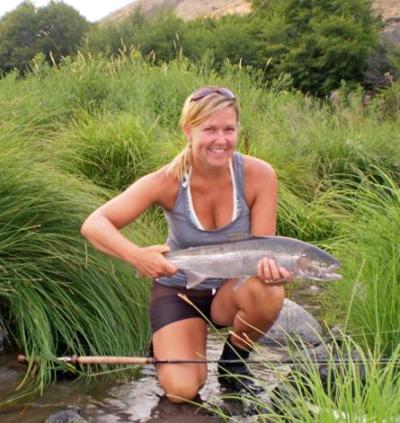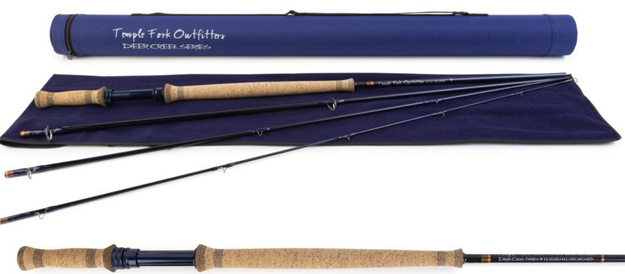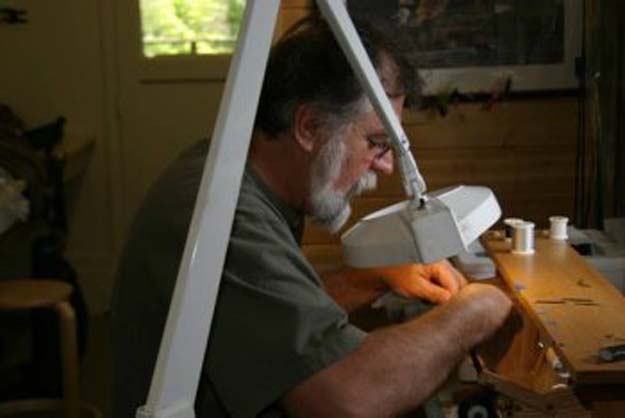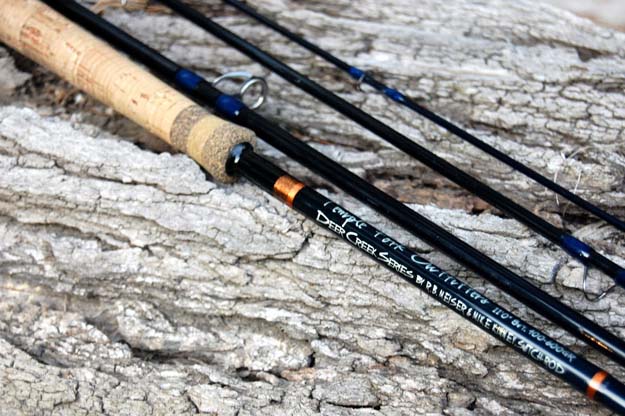Is a switch rod to a conventional fly rod what a spear was to a club™?
[dropcap]N[/dropcap]o one is going convince a logical person of the angling persuasion that a “new,” top end fly rod from any one of the majors here in the U. S. is not better to cast, make tighter loops, endure for a lifetime, be surprisingly stronger and lighter than a fly rod made in the land of Oz for one-third of the price.
There are those who suffer from mental illnesses and can be heard saying, “My $125 XYZ rod bought on eBay is as good a Sage SALT.” And “they” also say there is no scientific proof of man-made influence on climate warming. They are not at fault; they seem to have been born that way – runnin’ their engine with nobody driving.

An R. B. Meiser Highlander Switch along with good angling had its reward. Photo R. B. Meiser Fly Rods.
Looking back to see ahead
Bob Meiser is the American author of the switch rod. The term “switch” got that moniker because a day of casting multiple types of fly lines to ascertain the best performing combination for that “new” short Spey rod resulted in a comment about so damn much “switching” and voilà, “switch.”
The first switch rods were nine foot, nine inches and made by Meiser for angling friends who were sick and tired of physical demands created by double hauling in preparation for each single-handed cast. That was in the mid-1970s.
The first switch rod ever sold as a company product was by R. B. Meiser Fly Rods. That was in the mid-1980s.
Using two hands to overhand cast was especially appealing to anglers requiring repetitive long distance deliveries typical of search casting for large game fish from a boat, beach, or hemmed in riverine topography.
After Mieser started showing up at west coast fly fishing shows and grabbing all the attention, the big name rod builders quickly capitalized on Meiser’s switch concept.
Fast forward; the major industry players drifted toward switch rod performance characteristics that were more Spey like – a commercially driven yield demanded by users – Northwest U. S. and British Columbia, Canada big water Spey anglers.
Staying closeted, was that an industry marketing mistake?
Meanwhile, little was done to market or introduce switch rods to other audiences like the cowboy west, Alaska, Mid-America, east coast, or Florida. A successful penetration in the Florida market with a 9′, 9′ switch rod, game enough for tarpon and sails and being a perfect “boat” rod would have lit a thousand candles.
For decades, switch rods have stayed isolated in the Northwest and British Columbia. Critics there still pooh-pooh switch rod Spey performance – not equal to the long rods of European descent they mimic. And on and on they go to this day.

Mike Kinney. Photo believed Spey Pages.com.
TFO Deer Creek Switch – the fly rod they got right the first time
Uniquely, the TFO Deer Creek switch rod series’ mandrels, build-out specs, and performance characteristics haven’t changed one iota since launch about a decade ago. Why? Well, it isn’t broken for a start. And two, it was designed by two guys that know more about switch rods than anyone on the planet, Bob Meiser, and Mike Kinney. It was out of Meiser’s shop, as already noted that the switch rod was born and Kinney, a veteran two handed rod designer, became a part of that.
Temple Fork has tweaked with Deer Creek’s “parts” and incidentals over the decade – all of which has drawn equal sentiments of praise and complaint, but the “engine” has never needed service.
What about these legally blonde folks?
Along the way, Scandinavians entered the realm of switch rods – embracing its duality and overriding single-handed casting benefits. They understood that a switch rod is not the “best” Spey casting stick. They left that puerile bar room argument to the Americans.
The Scandinavians accepted switch rodding in its purest form, capable of exceptional single handed casting, fearing no fly eating backcast and practical and accurate two handed casting with a maximum rod length of 11-feet.
Redefining the switch rod and how to cast it most beneficially
The Scandanavians demurred to the “Yank” inventors terminal length, an 11-feet limit because that extracted the best dual performance from a switch rod. Why an 11-feet limit? Simple, try casting overhand any rod longer than 11-feet for an hour, even 6-inches longer, and your arm will reach out to your brain and say, “nuff.” Some at 12-feet are called switch rods, but it does not make it so – too clumsy and physically demanding in single-handed casts.
Another strangeness with the Scandinavians is their two-handed casting technique which is way, way better than most engage in on this side of the pond.
Scandinavians use the lower, offhand as the lever – pulling, not pushing with the dominant hand. In the states, not so clearly defined mechanics. Some “pros” have videos claiming that engaging the upper hand as a “pusher” lever helps add distance. Hmm, got that wrong.
Pull, doing what doesn’t come naturally
It’s an easier, softer way to cast better all day by simply not using your dominant hand (upper hand) as the “pushing” lever. Use the lower hand to pull the rod toward you – better accuracy, longer casts, and no arm, wrist or shoulder strain. You just need to use a two finger hold at the very base of the rod – index and middle digits.
The switch has always been the perfect boat rod, and Alaskan guides proved it. The switch in Alaska is the go-to fly rod – hop in.
The TFO switch does not have closely related “Middle Class” relatives with the exception of Rajeff’s Echo 3.
About the Echo 3 switch option at $525
Echo 3 switch rod limits have nothing to do with its castability, build, durability or performance in any category, but it has everything to do with selection. Rajeff limits the choices of his 11-foot versions to 6-, 7- and 8-weights. These weights are all saltwater fish weights – big fish. The Echo 3 in an 8-weight is for fish in the 10- 12-weight class – offshore animals or early season Chinook salmon.
They can, of course, play well where smaller fish roam by the way they’re rigged (6-weight).
Offering more
A selection that included lower weights in Rajeff’s Echo 3 switch rods would create new leadership in mid-priced, high-performance switch rods – a league of their own. Surprisingly, that would make a total of two hi-performing switch rods in the Middle-Class cost range.
There is no hesitation calling the TFO Deer Creek Switch the best angler and pocketbook friendly fly rod series in the entire industry. The real-time performance of this multi-purpose fly rod is designed to improve anyone’s angling enjoyment and performance. That would include anywhere, in any environment and angling for any species (not marlin, but certainly sails).

The TFO Deer Creek Switch rods are all 11-feet, 4-piece, covering line weights 4- thru 9-weight and rig with 200 grain to 700-grain weight fly lines. Current pricing is $410 for lower weight rods to $430 for heavier weight rods. Contact your local fly shop for a test drive.
Transition without interruption
The TFO Deer Creek switch rods series is a superb example of rod building at its best. When casting one you’re in touch when single hand casting or working a variety of water hauls.
TFO Deer Creek Switch rods are most notably rare in that Middle-Class price range. As a production rod, they are action consistent from weight to weight. The four does not have a different action feel than the nine – one does not bend at the handle and the other at the tip-top section. That is no small trick and no doubt the signature of Kinney and Meiser. It is also another reason why the original design hasn’t had to be “fixed,” morphed into a new brand name, or be called son-of-Deer Creek.
Perhaps the sweetest characteristic of the Deer Creek’s is their being “sooo” easy to pitch comfortably for extra inning games in either two-handed or single-handed set ups. Your long rod companions, as well as the nine footers, will have worn their day out before you’ve given it a thought.
It’s not all a bed of roses
So far, the only rub is that it’s not the best at what a tournament bass angler would curse any softer striking rod for – not POW when setting the hook. Yup, it yields that for better casting, but we’ve found that like any good heavyweight fighter, a Deer Creek can take a punch. If you get a “bass like” fish to eat, abuse the rod, it can take it. Slam it, which is sometimes hilariously funny. Although on a sipping fish – even a tarpon sometimes, a “too soon” whamo set can reintroduce you to your fly at Star Wars velocity.

The man who gave us the switch rod. Bob Meiser. R. B. Meiser Fly Rods image.
So, what about the top U. S. made switch rods?
R. B. Meiser Fly Rod company is the best in the world at producing a complete line of switch rods or anything two-handed. No other U. S. rod builder has as complete a line of switch rods or two-handed fly rods.
Some major name brands have great rods called switch, but they are sometimes too long to perform well as single handed. So they are in a category called mislabeled. A few have terrific switch rods but only in one or two weights?
Most rod makers with switch offerings have one foot in and one foot out – only chocolate and vanilla, or devoted to special angling needs. Winston, for example, hit a home run with their entry they called Micro Spey. They are beautifully performing 3-, 4- and 5-weight switch rods, “ . . . That which we call a rose by any other name would smell as sweet . . .”
There is one not so small issue with every fly rod made, and it’s huge with switch rods. What is the best fly line for the rod based on how it’s built to perform, and where and what are you’re fishing for?
We’ll attempt to make sense of that baffling subject in coming features . . .
NOTE: Featured Image is a perfect example of how to use the lower off-hand as the cast instigating lever. Notice his hand – only a two finger grip and at the terminal end of the handle. Image Credit Line Speed Jedi.
INFORMATION:
Temple Fork Outfitters
8105 Sovereign Row
Dallas, TX 75247
Phone: 800.638.9052
Fax: 214.638.9053
info@tforods.com
Website . . .



